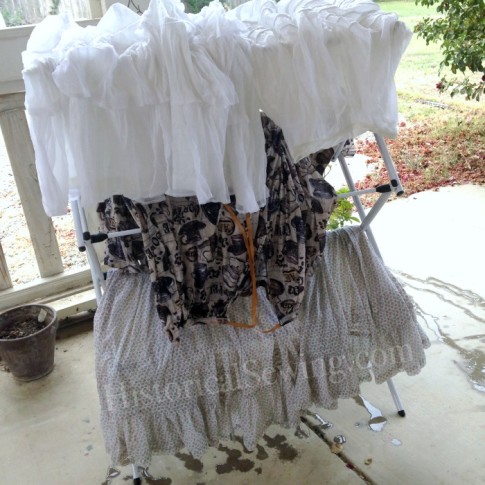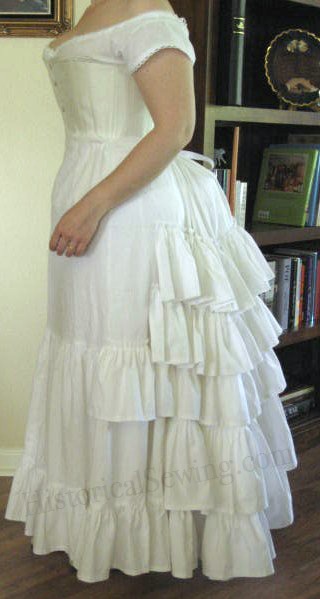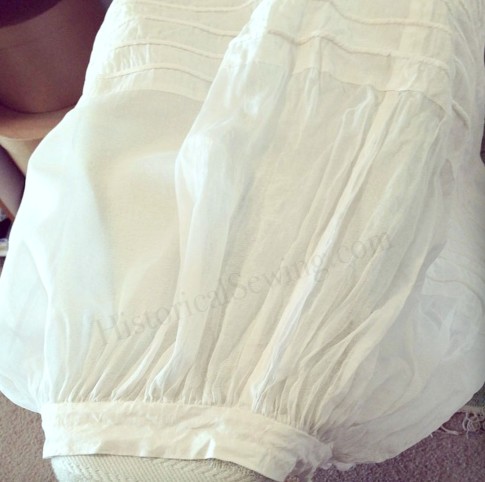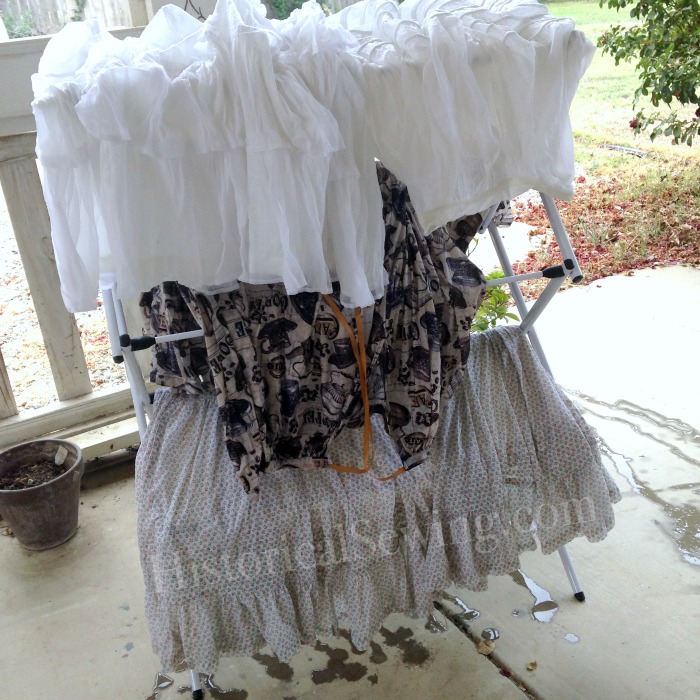
Do you starch your petticoats? Like those that are required if you want a good historical silhouette?
I’ll admit I don’t keep my petticoats freshly starched & pressed as much as I should. But I still remember the very first time I pressed a plain petticoat after starching for the first time. OMG!
That “paper finish” we all read about? Yeah…. that happened. Don’t know why it took me so long to try dip starching! When you’re ready for that Oh.my.gosh moment too, here’s the tutorial you’ll need.

Nothing can be compared to a nicely starched petticoat. Doesn’t matter if your petticoat has ruffles or is plain or has rows of cording, a starch treatment will keep it stiff, giving excellent support to the over dress. Starching also allows dust to be easily brushed off. Depending on the heaviness of your starching, it will give your petticoats that slight “rustle.” Hehe
Most of my petticoats are cotton. Ok, well, all of them except for one that’s in linen. Cotton is what you’ll find for most Victorian petticoats (as we recently discussed). And the reason is because it simply washes and starches better than other textiles. I highly recommend sticking to cotton for petticoats if you plan to starch.
Although it is not recommended to starch silk fabrics, if you have made a silk petticoat, do a test before dunking the whole garment in the wash bin. Silk petticoats are lovely and some do not necessarily need starch to stiffen.

Liquid Dip Starching
I don’t know about you, but if I’m going to take the time to starch & press my petticoats I’d rather use the best technique first, right? This happens to be soaking (aka dipping) the entire petticoat in starchy water rather than spraying starch from a can (more on that below).
You will be AMAZED at the results of dip-starching your petticoats! Honestly. I was floored. (Ok, for those of you who starched petticoats in the 1950s & 1960s you probably know all this already. Feel free to comment below on your experiences. 🙂 )
The easiest way to dip-starch your petticoat is in a large wash bin. (You can use your bathtub too but will need to clean it well afterwards.) I’ve found galvanized tubs are perfect for the job and come in various sizes. They can be found in your local hardware store – look in the garden and/or paint sections.
Note: You can starch in the washing machine but it’s at your own risk.
1. Decide on how stiff you want your petticoat to be.
Use the following proportions of water to liquid starch. Your batch can be made to any size, but keep the proportions. You will find you can make your batch small, using only a few cups of water. You only need enough to get the entire petticoat wet and soaked (thank goodness, right?).
Use the Heavy or Medium stiffness strength for historical petticoats.
Very Heavy: Full strength liquid starch (very stiff), use conservatively
Heavy: 1 part water to 1 part starch
Medium: 2 parts water to 1 part starch
Light: 4 parts water to 1 part starch
2. Dip your entire petticoat in the tub. Turn it over in the tub several times to wet it all down. Let the fibers soak in all that goodie starch water! Gently squeeze excess water out.
You’ll want to make sure you dip a *clean* petticoat or you’ll have it soaking up dirty starch water that will remain in the fibers. Eww! Starched petticoats don’t need to be washed as frequently, so wash first; then starch.
NOTE: You can continue to use the same starch water for as many petticoats as you need to stiffen. Don’t let it go to waste!
Lay flat to dry completely. A fully dried petticoat is the key when dip starching.
3. After it’s fully dry it’s time to iron your petticoat. Whenever you iron a garment to stiffen the starch or apply it, protect your ironing board with a towel.
Lightly spray your petticoat with water, only until damp. Do not soak it! You merely want to get it slightly damp to activate the starch in the fibers.
Use a hot iron on a cotton setting to press. As you iron you will see the paper finish come alive and the iron glide smoothly over the fabric. This is your OMG moment!! Enjoy! 🙂

A Quick Word on Using Spray Starch
If you are looking for a quick, light starch finish, then the spray can is for you. You can achieve a medium starch hold using the spray starch, but it takes a lot of work! Do not try to spray starch a ruffled petticoat. You will be working for 8 hours on it! Dip starch those ruffles instead. 🙂
You can begin with a dry petticoat when spray starching. However, you can also spray water very lightly on the fabric first then spray the starch. Following the can directions, spray the starch over the fabric on your ironing board. Then press. (Only spray and iron a section at a time.)
After spraying the starch, allow it to “set into” the fabric for a few seconds – no more than 30 – before ironing. This allows the starch to wrap around the fabric fibers for more stiff coverage.
Storing Your Starched Petticoats
You put in many hours creating your historical clothing items. As with all your period costumes, storage of your starched petticoats requires some thinking.
If you are using purchased chemical starch you won’t need to worry as much. Although, if you decide to go authentic and use a homemade potato/rice/corn starch, be cautioned that it will attract insects. Cedar balls or cotton balls with essential oil (peppermint, lavender or lemongrass oils recommended) are good repellants. Be careful not to store the balls actually ON the fabric but in sachet bags.
Petticoats ideally should be stored flat in a drawer or acid-free box. You could also roll them with tissue paper. Do not wrap or store petticoats (or any costume) in a plastic bag or tight plastic bin. The fabrics need to breathe.
Enjoy your freshly starched petticoats!!
Do you have another method for starching petticoats? Any vintage tricks you’ve tried that may work better? Share in the comments below!


I have a 60 year old cotton christening gown (with very narrow lace) that I need to iron. Could I dip-starch it like your petticoats?
Check the fabric first to see if it could stand up to washing. I believe it would being from the 1940s. But do check first. If it can be washed, it can be starched. Of course, be very gentle and don’t hang or lift the gown out of the water from the shoulders. Keep it in a flat position. (That said, I’m not a textile conservationist or expert.) Good luck!
Thanks. Yes I have already washed it. I assume I would want the lightest starch (4:1)
Should I iron on the wrong side? And how do I iron the lace? Iron it flat?
When in doubt, press on the wrong side. Not knowing what your lace looks like, a gentle press flat is fine.
thanks so much for this tip! I never thought to starch my petticoats, but it makes a world of difference!
I’ve always wondered how to deal with my heavily ruffled petticoats. Do you just iron some of the wrinkles into the ruffles? Or do you just iron the bottoms of the ruffles? I have tried to avoid directly ironing anything that is ruffled, and stick to the pleats. I am tempted to add a new petticoat for my new TV208 skirt…
It’s personal choice. I’m rather particular so will iron my petticoat ruffles from the hem up. But should only have to iron them after washing (and/or starching). I wear my petticoats often before washing unless I really sweated through to them.
I have always dip starched my formal damask table cloths and napkins. For some unknown reason it never occurred to me to dip starch clothing! (Doh!)
Do any other oldies like me remember ironing petticoats with wax paper?
All my years of ironing clothes I was taught a to spritz the clothes with water and wrap in a sheet also damp and then put into the refrigerator to be ironed the next day. I ironed for our entire neighborhood, Parochial Schools and working dads needing those white shirts. I started ironing when I was about 9. I still love to iron.
Does anyone have a good receipt for homemade starch. I can’t find laundry starch anywhere.
I don’t want to use spray starch.
Try Amazon and also Ace Hardware and even Walmart for commercial stuff. It may be local quirks, but I can get huige bottles of liquid starch at Walmart.
The classic home-made is water and corn starch in various concentrations. Don’t boil too long or the corn starch loses its texture.
Recipe #1
2 ½ cups of tap water and 1 ½ tbsp corn starch, whisk thoroughly to get rid of lumps
Bring to a boil and simmer for 1 minute
Cool to room temperature before filling spray bottle or dunking the petticoats.
Recipe #2:
Mix 1/4 c. corn starch into 1/2 c. cold water until smooth
Stir in 4 c. of boiling water
Mix and cool
CAUTION: home-made and “starch granules” scorch easily. Home made will grow mold if you try to store it, so make what you need, dip the petticoats and don’t try to keep it.
Awesome! Thanks for sharing the recipes.
I work in a 1890’s living history museum in the middle of Nebraska where temperatures can reach 90 degrees plus and humidity not much less in the summers. There is no such thing as air conditioning in the 1890s. My building was built in the 1860’s and a portion of it is adobe. We wear primarily cotton for our daily wear. I starch everything but do not wear a corset due to serious medical problems. I have also found success in wearing a very light weight washable wool skirt which does up nicely and wrinkles hang out over night. I starch it too.
on Starching if you are dip starching you can hang them till they are damp then hang them upside down so that the ruffles are inverted it reduces how much pressing you have to do and gives max lift, and steam irons ended needing to spray water onto the starch as a retired professional costumer i recommend you put the non stick iron shoe on to keep from getting starch build up in your iron that can turn brown and spit onto something when you least want it to and to help keep from burning the petticoats as using the liquid starch or the make your own can stick to the iron. We did a LOT of rewashing with the old starch but it works so much better I use to do all my Dads Army uniforms with starch I cooked on the stove.
Would it be wise to starch a cotton Regency dress including the petticoats, or is starch only intended for petticoats and not for dresses?
No, you can starch dresses, but I would not recommend doing it on Regency wear. Their style is meant to be loose and limp and airy – starch doesn’t give you this. The chemisettes and collars could be lightly starched, but not dresses. I personally don’t starch my Regency bodiced petticoats either. They provide the support and still be flow-y for the dress.
When dip starching I don’t let the garments dry all the way but leave them fairly damp then roll them up like a bed roll, put in a plastic bag and leave in the bottom drawer of the refrigerator till the next day. Then when you iron them they are perfectly damp and you don’t have to do anything else to them. If I need to touch up a petticoat or if it dries before I get it ironed use spray starch to dampen your petticoats. Makes them a little stiffer and you don’t have to worry about diluting your starch job.
My mother got sent home from school in the early 60’s for having to many heavily starched petticoats. Apparently her skirt was horizontal.
Haha! That’s great. (the skirt part, not the being sent home part)
Are there any tricks to traveling, say to Costume College, with starched petticoats?
Nothing beyond normal packing. The top photo here is all my heavily starched petticoats drying the weekend before Costume College. After drying I pressed them all then folded into the suitcase. No problems when I pulled them out to wear!
Good to know! I have many petticoats that need starch!
When I have a lot of ironing to do that requires starching, I spry each section of the garment with heavy spray starch, roll the garment up tightly and place it in a plastic bag, I leave it in there for several hours or overnight and the next day the entire garment is damp and ready to iron. I keep a water spray bottle nearby if the the fabric begins to dry out , and presto another OMG moment. It comes from my growing up days when we “sprinkled” our clothes and put them in a bag to dampen before ironing. Boy was I glad when no-iron fabrics came out and actually worked!
I haven’t tried dip starching yet, but I have made my own spray starch, and it created a very nice finish, too–far better than the store-bought cans! I usually use my homemade spray starch for making bias tape, and the difference in the quality of the tape when I do that is amazing. (I usually iron it in after cutting the long, continuous-bias strip, before folding of any kind.)
I do want to try dip-starching a petticoat, though, so I’m glad to have this tutorial! I’ll probably have to make my own simply because I have yet to see anything but the cans anywhere in my area, for some reason. I think I want to try it on my EGL petticoat first….
Regarding storage, think in two terms. 1) Storage during the “wearing” season, and 2) storage during the “storage” season.
It is fine to store a petticoat in its starch during the wearing season, but once you put that season’s garments away, wash the starched items well and store them unstarched.
Have fun wearing those starchy petticoats!
Good point! Thanks.